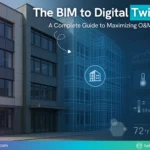Technology Trends that will Disrupt the Future of Construction Industry
April 27, 2022

The AEC industry has been known to be a slow adopter of technology over the past decade. COVID-19 pandemic accelerated adoption across the value chain. Contractors, architects, project co-ordinators and other onsite professionals are now looking at ways to improve efficiencies, optimize costs, reduce time to build, enhance safety standards and improve sustainability metrics. Technology is the answer to their quest.
Take a look at some construction Technology Trends that are transforming the AECO industry:
Building Information Modeling (BIM)
Building Information Modeling (BIM) is a process that helps us build 3D models, which are a digital representation of the physical and functional characteristics of a building/structure. It is the stepping stone to turning around the performance of any project. Real-time visualization of the project through BIM models allows for concurrent updates by the stakeholders and saves a significant amount of time and resources. The cloud-based model makes access to project information location and time agnostic. This information transparency of design and project management fosters better collaboration and conflict resolution between project teams, and faster project completion. If the full potential of 3D to 8D BIM is leveraged, construction projects will move notches above their current efficiency level in terms of time, cost, materials, safety, and sustainability.
Digital Reality Capture
Countries across the world are grappling with aging infrastructure. A majority of these old structures only have 2D physical documents as the information source for planning renovation. Manually modifying these blueprints is tedious and time-consuming. That’s when technology like Digital Reality Capture comes as a boon. Digital Reality Capture refers to the process of scanning the physical asset to create a 3D digital representation of the building. Laser scanning or photogrammetry is used to measure various surface points and other building elements to produce an accurate 3D model. The data captured through this process provides information about the location of existing – assets. This makes it easier for architects and engineers to plan the renovation, detect clashes early, and make smarter decisions in design and usage of resources. Digital Reality Capture is an accurate survey technology for small and large infrastructures including in accident-prone areas. It reduces labor, saves time, and assures safety of workers.
Automation
Many construction companies are embracing automation technologies for labor-intensive, time-consuming, and risk-prone tasks. Automation of tasks across the entire construction lifecycle from planning stage to on-site construction to post-construction asset management is now possible. For example, automated or self-driving trucks and forklifts can help transport construction material across the construction site, thus saving time and effort.
Another effective tool is the drone which can be used for pre-construction surveys. It can also be used for monitoring the site during the construction phase to identify possible risks. Similarly, there are IoT (Internet of Things) – based sensors that collect real-time data such as location, pressure, temperature, and other aspects for the various equipment’s from a building during operations phase. Machines can be automated based on this data. For example, fabrication and welding machines can be automated with a particular action based on the signals received from the sensors.
Virtual reality and augmented reality are some more powerful examples of automation in the AECO industry. In virtual reality, 3D scanned images are used to create a simulated environment of the building. It facilitates site walkthrough that helps architects and other project stakeholders to plan construction. It can also simulate dangerous situations like fire or natural disasters to assist project members in preventive maintenance. Augmented reality provides real-time information on the construction site. For example, a person installing an electrical cable tray can see the plumbing pipes that are yet to be installed. He will then install the trays to avoid clashes with the cable tray.. Both augmented reality and virtual reality can foresee and overcome design or on-site construction problems.
Robotics
Labor shortage remains a persistent challenge for construction companies. Construction robotics is a great solution to overcome this challenge and build faster and error free. Labor-intensive tasks such as bricklaying, welding, painting, rebar tying, loading materials, etc. can be easily achieved by construction robotics. This technology helps reduces human effort and minimizes probability of errors, improves productivity, reduces construction time, and guarantees site safety.
These collaborative technologies and smart tools help improve accuracy and efficiency, reduce manual labor, save time and money. The most important aspect of these technologies is that they enable connectivity which is time and location independent. These technologies help construction companies adapt to the ‘new normal’ and other unforeseen challenges that can impact the construction lifecycle.















